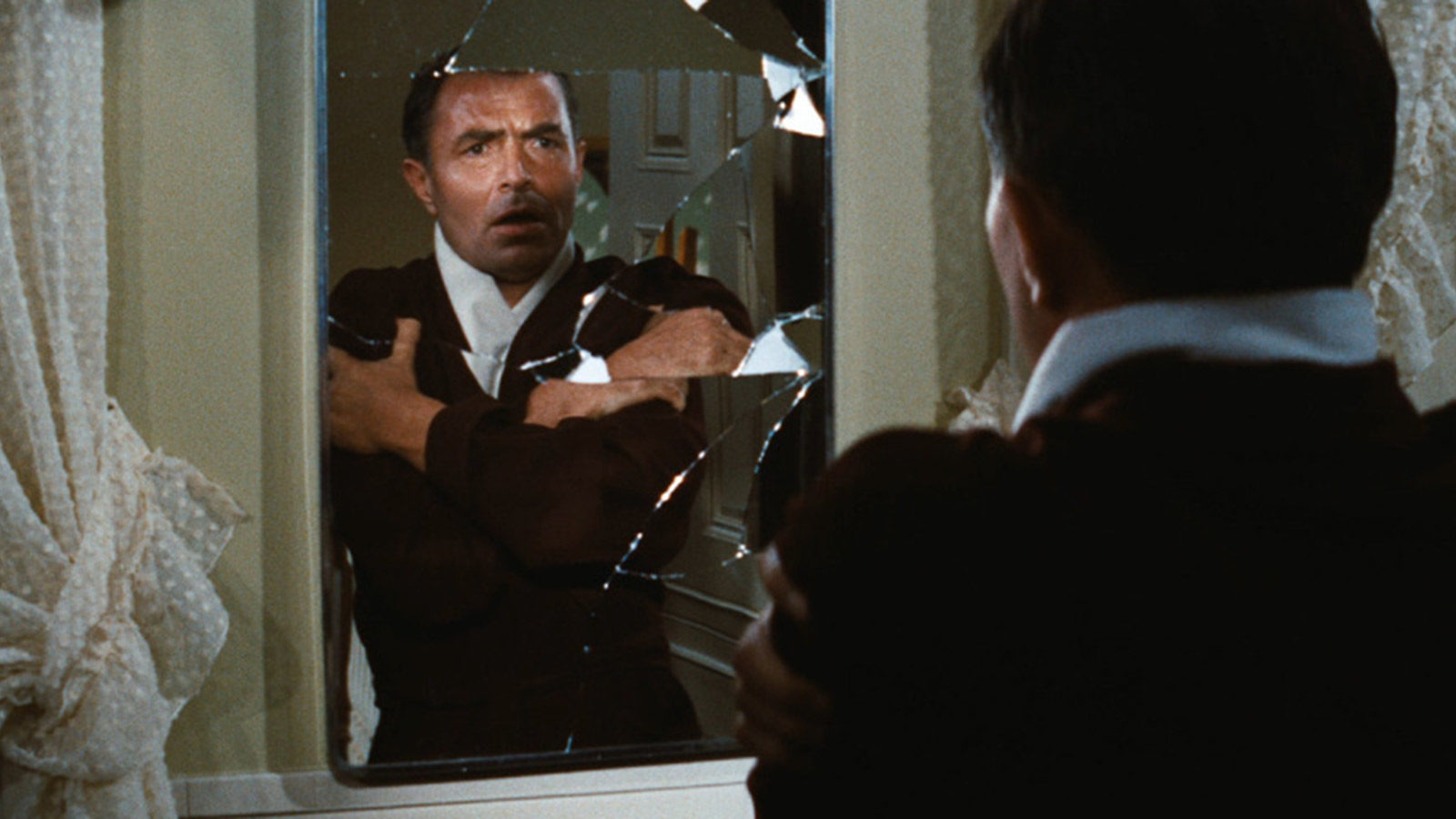
Review: Bigger than Life
Half a century before Daniel Day-Lewis drank Paul Dano’s milkshake, fellow Brit James Mason—playing another American megalomaniac in Bigger Than Life—served up some equally memorable moments of milk-inspired madness.

It starts with an unprovoked explosion at the deliveryman. “You’ve gone out of your way to annoy me,” Mason snaps when the drippy old man, decked out in a clownish Good Humor outfit, arrives with his clinking glass bottles. “You jingle-jangle in and you jingle-jangle out. Don’t lie to me, it’s deliberate!” The dumbstruck milkman tries to defend himself. “You folks and me, we’re real friendly. Why some mornings I even take your boy with me on my rounds, just ask him!”
Ah yes, the boy (Christopher Olsen). James Mason hasn’t forgotten. The boy shall not get any milk or supper until every last one of his math problems are completed. James Mason doesn’t care if it takes all night. It’s for the boy’s own good. But the boy’s mother (Barbara Rush)—always sneaking around behind Mason’s back! always undermining his best laid plans!—covertly smuggles some creamy contraband to her traumatized child, unleashing a second wave of dairy derangement:

Sitting in frozen silence before the endlessly delayed dinner, wife and son look on in terror as their domestic dictator carefully pours his milk back into the frosty pitcher. That another glass remains unaccounted for is clear from the high-water mark. Their treason is apparent to all. “Did you really think that you were clever enough to outsmart me?” Mason asks, his voice both seething with rage yet frighteningly calm.
Clearly, they weren’t all happy days in Eisenhower’s America. Released in the summer of 1956, director Nicholas Ray’s Bigger Than Life represents one polar extreme on a truly schizophrenic slate of Hollywood fare. The year’s box-office was dominated, on the one hand, by a cycle of globetrotting spectaculars that eagerly exploited the era’s new widescreen technologies: The Ten Commandments, Seven Wonders of the World and Around the World in 80 Days comprised three of the top five grossing pictures. Visually sensational but dramatically saccharine, this mid-century cinema of attractions exudes a logic not unlike the “least objectionable programming” mantra that was the implicit (and soon to be official) philosophy of the burgeoning television industry: in the pursuit of the broadest audience possible, everything remotely provocative, salacious, or morally complex has been carefully excised in advance, reducing these films to the level of lowest-common-denominator inoffensiveness.
Head a little further down the box-office charts, however, and you’ll start to feel like you’ve slipped into the country’s collective unconscious. In addition to aggressively marketing candy-colored hokum to the family-values crowd, studios also took advantage of a liberalizing production code to produce more “adult” material. As with Mason’s turn in Bigger Than Life, films like The Man Who Knew Too Much, Seven Men From Now, and The Searchers allowed the good old boys of Hollywood’s golden age—Jimmy Stewart, Randolph Scott, and John Wayne—to give free reign to their usually suppressed psychoses. In these pictures, which the trade papers euphemistically referred to as “psychological,” a shocking criminal act (kidnapping, murder, or both) opens up a Pandora’s box of primal emotions and antisocial desire, confronting audiences with the darker dimensions of Hollywood heroism. In their intricate imbrications of star text, iconic Americana, and insinuating directorial commentary, these dark and disturbing films systematically subverted the reassuring conventions of classical Hollywood. It’s as if one of the American-dream factory technicians broke the Emergency Use Only glass and flipped the red switch to “nightmare.”
Bigger Than Life begins somewhat differently from its peers, set in the sanitized suburbs of a Father Knows Best sitcom rather than the brutally Hobbesian universe of the Western or international spy thriller. Mason’s Ed Avery is the very image of middle-class normality, just your average-hardworking-American: faculty head of the PTA, former soldier, and churchgoing football dad. Although he is a senior staff member at an elementary school, Ed also works part time in the evenings—takes the last bus home, god bless ‘em—in order to provide for his lovely wife and angelic son (played by Christopher Olsen, the child actor of late 50s Hollywood and the older brother of Susan Olsen, aka Cindy Brady of The Brady Bunch). Ed Avery’s life is almost a cliché. It’s as if he were a stock character from an October stump speech—just call him Ed the Schoolteacher.
But when tragedy strikes in the form of an unforeseeable illness, this superficial patina of domestic bliss and financial prosperity is quickly shattered, and the darker reality so neurotically concealed by an outwardly “perfect” existence is laid bare in all its Grand Guignol grotesquerie. The premise (along with the title) was lifted from the 1956 New Yorker article “Ten Feet Tall,” which narrated in clinical detail the case history of “Robert Laurence,” a schoolteacher and family man. Diagnosed with periarteritis nervosa, a debilitatingly painful and ultimately fatal inflammation of the arteries, Laurence was placed on a high-dosage program of Cortisone supplements, a medication that was then in its experimental stage. Within a matter of days, Laurence’s symptoms disappeared and his pain faded away. He felt like a new man. No, even better: he felt like a superman: “I felt as bright as a button—capable of anything. It was really extraordinary. It was almost as though I’d never been fully awake before.”

The only problem was that Laurence’s hormonal supplements had a few unexpected side effects: manic-depression, paranoia, and delusions of grandeur. He began to have some peculiar ideas, most of which revolved around his suddenly obsessive preoccupation with time management—both his and his family’s: “With my wife, there is a desire to impress upon her the rightness of my views, to mold her and to change her until she conforms completely to the artificial pattern I am setting up for her.”
As this scenario is retooled in Bigger Than Life, the central thematic question becomes one of causality: does the cortisone treatment create the psychotic impulses that transform Mason’s Ed Avery from a mild-mannered schoolteacher to a petty Fascist? Or does it merely amplify the psychic force of a mindset that’s deeply ingrained before the first pill is popped? While the film ostensibly allows the viewer to accept the “easier” explanation—reading the narrative as a literal-minded docudrama about a dangerous new drug—the carefully structured screenplay (crafted by a number of writers, including an un-credited Clifford Odets) establishes the foundation for every psychotic symptom in the first act of the film, that is before Mason is prescribed the controversial drug.
After the opening credits roll, the first image we see is an insert of a pocket watch. A hand reaches into the frame to pick it up when (with a jarringly dissonant orchestral cue) it suddenly contorts in pain. A series of wider shots reveal that Mason—momentarily racked with the headaches and dizzy spells that will quickly escalate as the film progresses—is holding a young student after school until he can successfully name America’s five great lakes. The examination reveals an educational paradigm that’s less concerned with inculcating creativity or independent thinking than with forcing students to systematically reproduce prescribed (and personally meaningless) bodies of knowledge. (In a later scene that’s played for sardonic laughs, Mason dismissively refers to the finger paintings of the preschool class as “grotesque daubs”: if it’s supposed to be a picture of a cow, then “Why does it have five legs?”) Yet because Mason starts out so temperamentally good-natured, this initial classroom interaction seems benign—when the boy offers up a tentative “Lake Huron?”, Mason smiles and lets him go.

But Mason is now running late for his second job. (That pocket watch keeps tick-tick-ticking.) He places a quick call to his wife who, small caveat, has no idea that her husband is moonlighting in the evenings. (Avery’s job, as a dispatcher at a cab company, provokes his class anxieties: “She’ll think it’s beneath me.”) He won’t be home until later, he explains, because he has an “emergency school board meeting.” “Another?” she asks in quiet disbelief. Logically enough Ms. Avery assumes that her husband is having an affair, yet she is unable to confront him about it directly. She merely reminds him that they are hosting a dinner party later that evening and to hurry home before then.
Mason’s stiff-upper-lip inflappability notwithstanding, the psychic stress created by his overscheduled existence manifests itself in subtle ways. In the first twenty odd minutes of the film (which span a single evening in the story) we see Mason repeatedly taking off his bow-tie only to be wearing it again in the very next scene—it’s as if he’s being literally suffocated by his professional obligations, subconsciously desperate for an escape yet consciously forcing himself to remain disciplined. “Wouldn’t it be great for us to really get away one of these days?” he later remarks to his wife, in a house lined with travel posters and maps of distant cities he likely has never been to and can’t now afford to visit. And yet, these obligations are also self-imposed. At the dinner party that same evening Mason waxes nostalgic with a fellow schoolteacher: “Do you remember the days when we used to dread vacations because they interrupted our work?”
And so all of the problems are there from the beginning: the reassuring authority and steady-handed discipline of the Great Lakes quiz foreshadows the domestic despotism and iron-fisted sadism of the math “problems”; the underlying alienation of husband and wife blossoms into full-blown paranoia; Ed’s yo-yoing desires to work even harder and yet escape completely explodes into the extremes of manic-depression.

So is this whole social set-up rotten to the core? Or does the Cortisone treatment simply exacerbate small problems that can be reasonably dealt with under normal circumstances? Hovering between these two explanatory frameworks, the film presents viewers with an ambiguity that’s almost Brechtian in its political implications. (Indeed, one could trace a straight line from this film to Fassbinder’s Why Does Herr R. Run Amok? and Martha.) In transforming this topical expose into a more metaphorical critique of the nuclear family, consumer society, and the social (mis)education of children, the film resonates with ideological implications that still have the power to unsettle.
In our mass mediated imagination, “the 1950s” have become a latter-day Victorian era. The historical shorthand of contemporary pop culture characterizes the decade as socially repressive and laughably naïve, a “pre-enlightenment” period that’s downright quaint from our ultra-modern perspective. But the issues presented in Bigger Than Life—the need to hold down multiple jobs just to get by; the inability of hard-working families to pay for their skyrocketing medical bills; the pervasive obsession with social status that encourages individuals to go deeper into debt merely to maintain a certain level of conspicuous consumption; and how all of these everyday pressures can explode into shocking acts of unexpected violence (“How could it happen here?”)—all of these problems are unsettlingly familiar to contemporary viewers.
Bigger Than Life may have been marketed as a social problem picture in 1956, but in 2008 it looks like nothing less than an out-and-out horror film. See it and I guarantee that you’ll never be able to look at a frosty glass of milk the same way again.







